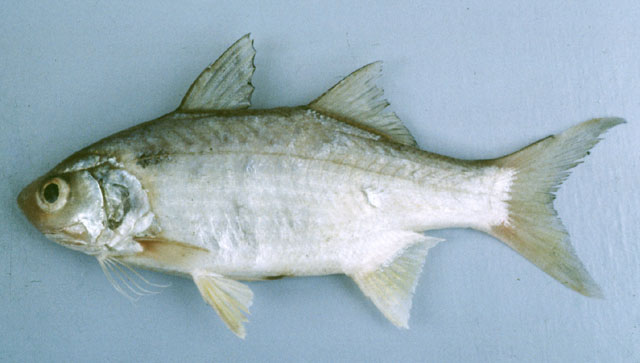Polydactylus
microstoma
(Bleeker,
1851)
Smallmouth threadfin
View all media / Upload your photos and videos
Expand all
Classification / Names
Teleostei (teleosts) > Carangaria/misc (Various families in series Carangaria) >
Polynemidae (Threadfins)
Etymology: Polydactylus: Greek, poly = a lot of + greek, daktylos = finger (Ref. 45335).
More on author:
Bleeker.
Environment / milieu / depth range / climate zone / distribution range
Marine; brackish; demersal; depth range 2 - 55 m (Ref. 57343); tropical; 26°N - 23°S77°E - 168°E.
Distribution
Eastern Indian Ocean and Western Pacific: Tamil Nudu, India to Myanmar and Phuket, Thailand; then from Taiwan to Indonesia and New Caledonia.
Maps

Polydactylus microstoma / Native range
AquaMaps Data sources:
GBIF
OBIS
This map was computer-generated and has not yet been reviewed.

Polydactylus microstoma / Suitable habitat
AquaMaps Data sources:
GBIF
OBIS
This map was computer-generated and has not yet been reviewed.

Polydactylus microstoma / Point map
AquaMaps Data sources:
GBIF
OBIS
This map was computer-generated and has not yet been reviewed.

Polydactylus microstoma / Year 2050
AquaMaps Data sources:
GBIF
OBIS
This map was computer-generated and has not yet been reviewed.
Size / Weight / Age
Short description
Dorsal spines (total): 9; Dorsal soft rays (total): 12 - 14; Anal spines: 3; Anal soft rays: 11 - 12; Vertebrae: 10 - 14. With 5 pectoral filaments; uppermost not reaching to (or extending slightly beyond) posterior tip of pectoral fin. Pectoral fin, rays short, 17-20% of SL; all rays branched except uppermost 1 or 2. Second dorsal spine long, 7-9% of SL. Well-developed swim bladder. A large black spot anteriorly on lateral line (Ref. 40958). Posterior margin of maxilla reaching to (or slightly short of) level of posterior margin of adipose eyelid. Lower tip of 7th proximal pterygiophore of 1st dorsal fin directed backwards. Lateral line squamation on caudal fin unbranched, extending to upper end of lower caudal fin lobe (Ref. 40970).
Biology
Main reference
Motomura, H. 2004 Threadfins of the world (Family Polynemidae). An annotated and illustrated catalogue of polynemid species known to date. FAO Spec. Cat. Fish. Purp. Rome: FAO. 3:117 p. (Ref. 57343)
IUCN Red List Status (Ref. 125652)
Least Concern (LC); date assessed: February 04 2009
CITES (Ref. 131153)
Not Evaluated
CMS (Ref. 116361)
Not Evaluated
Threat to humans
Harmless
More information
- Countries
- FAO areas
- Ecosystems
- Occurrences
- Introductions
- Stocks
- Ecology
- Diet
- Food items
- Food consumption
- Ration
- Common names
- Synonyms
- Metabolism
- Predators
- Ecotoxicology
- Reproduction
- Maturity
- Spawning
- Spawning aggregation
- Fecundity
- Eggs
- Egg development
- Age/Size
- Growth
- Length-weight
- Length-length
- Length-frequencies
- Morphometrics
- Morphology
- Larvae
- Larval dynamics
- Recruitment
- Abundance
- References
- Aquaculture
- Aquaculture profile
- Strains
- Genetics
- Allele frequencies
- Heritability
- Diseases
- Processing
- Mass conversion
- Vision
- Pictures
- Stamps, Coins Misc.
- Sounds
- Ciguatera
- Speed
- Swim. type
- Gill area
- Otoliths
- Brains
Estimates based on models
Preferred temperature (Ref. 123201): 26 - 29.1, mean 28.3 °C (based on 772 cells).
Phylogenetic diversity index (Ref. 82804): PD50 = 0.5 [Uniqueness, from 0.5 = low to 2.0 = high].
Bayesian length-weight: a=0.01622 (0.00983 - 0.02676), b=3.05 (2.90 - 3.20), in cm total length, based on LWR estimates for this species & (Sub)family-body (Ref. 93245).
Trophic level (Ref. 69278): 3.9 ±0.0 se; Based on diet studies.
Resilience (Ref. 120179): High, minimum population doubling time less than 15 months (Preliminary K or Fecundity.).
Fishing vulnerability (Ref. 59153): Low vulnerability (15 of 100).
Nutrients (Ref. 124155): Calcium = 0 [0, 0] mg/100g; Iron = 0 [0, 0] mg/100g; Protein = 0 [0, 0] %; Omega3 = 0 [0, 0] g/100g; Selenium = 0 [0, 0] μg/100g; VitaminA = 0 [0, 0] μg/100g; Zinc = 0 [0, 0] mg/100g (wet weight);

